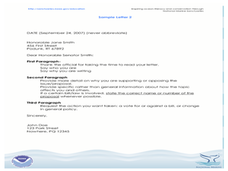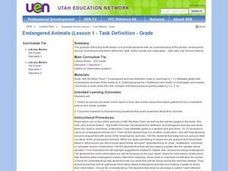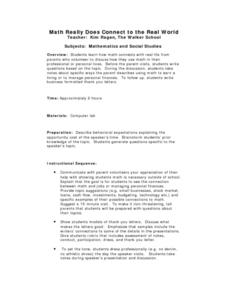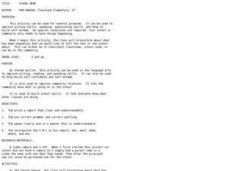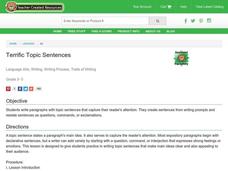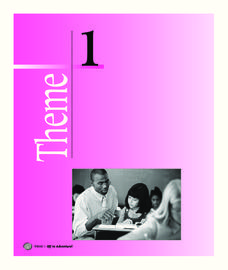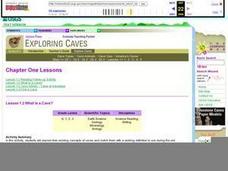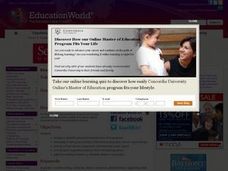Curated OER
Prehistoric Pen Pals
Students read online information and identify relevant information about a particular dinosaur species, assume the personality of a specific dinosaur species, and write online "getting to know you" letters to other student-dinosaurs in...
Curated OER
Creating a Classroom Constitution
Youngsters identify and interpret the importance of having rules in order to maintain order at home, at school, in their community, and in the United States. They create a working Classroom Constitution that governs the classroom and...
Curated OER
In My Opinion
Young writers craft letters to the government stating their opinion on different topics. They pick an environmental or ocean issue, research it, and craft their formal persuasive letter. Ensure your learners include supporting facts and...
Museum of Tolerance
Family Tree Activity
Discover the family histories that make the classroom with a family tree activity. Scholars locate information about their family, construct a family tree, and work together to tally where family members are born.
Center for Learning in Action
Introduction to Matter
Begin your states of matter lessons with a demonstration designed to introduce the concept that all matter has properties. Reinforce this concept through vocabulary exploration, and the creation of atom models; salt, water, and carbon...
Spreading Gratitude Rocks
A Note of Gratitude
Gertrude Stein once said, "Silent gratitude isn't much use to anyone." Learners break their silence by engaging in discussion and making lists of what makes them grateful. Next, pupils write and illustrate a thank you letter to a chosen...
Curated OER
The Right Choice
Have class discussions about decision-making and how to solve real life problems with your learners. They will watch videos, talk about truths, fill out outlines, and more.
Curated OER
The Nervous System Lesson
Students identify features of the nervous system. They explore the needs of the human body by explaining the importance of good health in relationship to the body and explain the functions and care of the human body and its organs.
Curated OER
Endangered Animals (Lesson 1 - Task Definition - Grade 3)
Third graders use The Big Six to gain an understanding of the phrase 'endangered animal.' They select an animal, research it and write a report about it. They also make a poster of the animal.
Curated OER
Math Really Does Connect to the Real World
Students listen to parent speakers who discuss how they use math in their professional or personal lives. They take notes and write business form thank you letters.
Curated OER
School News
Compile a school newsletter with your budding journalists! Use the school calendar to assign each learner a specific even to cover! Possible events include the science fair, sports games, concerts, talent shows, etc. This is a project...
Curated OER
Lesson 3: Measuring Angles
Young scholars use a protractor to measure angles. They classify angles by type: right angle, acute angles, and obtuse angles. Students build and draw right, acute, and obtuse angles. They discuss how do people in various professions use...
Curated OER
Tasty Constellations
Students conduct research on a constellation and create a model of it using marshmallows as stars. They draw the constellation in pencil on black paper, glue on marshmallows, and trace the pencil with chalk to connect the stars.
Curated OER
Terrific Topic Sentences
Capture the interest of your reader with terrific topic sentences. To practice hooking the reader, your class will be given writing prompts, and they must create topic sentences for each prompt provided. Encourage them to use different...
Curated OER
What Is the True Story of the Three Little Pigs?
Cozy up and listen to a recording of The True Story of the Three Little Pigs and The Three Little Javelinas. Then, lead your class in a compare and contrast of the two stories by creating a Venn diagram.
Curated OER
Let's Dig Deeper!
Young scholars investigate rocks and how they are formed and the uses man has for rocks. The topic is narrowed, researched, and documented by three sources. The results are presented to classmates for evaluation.
Curated OER
The Geography - Writing Connection
Students examine and describe the four physical systems of the Earth. Using two of the systems, they practice their writing skills and use vocabulary associated with the different types of landforms. They predict the types of shelters...
Curated OER
My School Goal (Part 3)
Third graders, while working in small groups, determine the meaning of evaluation and why they are evaluated in school. They individually assess themselves to determine how they did on their goal sheet, and prepare to continue the use of...
Curated OER
Traveling Community Journal Project
Students create an online "community journal". In this communities lesson, students use a writing template to send e-mail to various people to learn more about their community. The journal is passed from person to person.
Houghton Mifflin Harcourt
Off to Adventure!: Challenge Activities (Theme 1)
Off to Adventure! is the theme of an English language arts unit comprised of a variety of challenge activities. Scholars enhance skills and reinforce concepts by taking part in a grand book discussion, giving an oral...
Curated OER
What Is A Cave?
Students explore their existing concepts of caves and match them with a working definition to use during the unit. They name the two types of rock formations in which most American caves occur, and define "show cave" and "wild cave."
Curated OER
Using Color as a Pre-Writing Tool
To better understand how to compose a clear and well-organized paper, learners read short passages, write summaries, and make colored graphic organizers. This is a fully developed three-day lesson with suggested assessments.
Curated OER
Beanie Baby Biographies
Learners write a biography for their favorite Beanie Babies and then share their biography out loud. A simple, yet effective idea! Everyone loves their Beanie Baby!
Curated OER
Exploring Nature: Powerful Forces
Learners observe samples of artwork which use line, shape, and form to show movement and depict natural forces of nature. They create their own piece of artwork that shows a natural force and movement and then write a descriptive...


